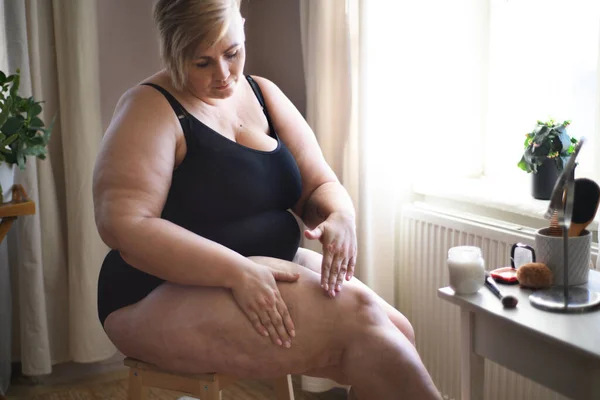For many women, changes in the appearance of their thighs, hips, or arms can trigger concerns about fat distribution or body contour. But what looks like harmless cellulite might actually be a misunderstood medical condition—lipedema. Though both involve the appearance of fatty or dimpled skin, they are not the same. And knowing the difference could be the key to getting the right treatment.
Cellulite is a cosmetic issue that affects up to 90% of women at some point, especially after puberty. It occurs when fat deposits push through the connective tissue beneath the skin, creating that signature “orange peel” or “cottage cheese” texture. It’s harmless, although often unwelcome.
Lipedema, on the other hand, is a chronic and progressive fat disorder that affects nearly 11% of women worldwide, according to estimates from vascular and lymphatic health researchers. Unlike cellulite, it involves a symmetrical buildup of fat, typically from the hips down to the ankles. This condition is often painful, resistant to diet and exercise, and frequently misdiagnosed as simple obesity or lymphedema.

What separates the two isn’t just their appearance but their underlying causes, symptoms, and potential health consequences. Understanding this distinction is critical—especially for women who experience persistent leg heaviness, easy bruising, and disproportionate fat accumulation.
Why Cellulite Is Less Problematic Than Lipedema
Let’s be clear: cellulite, while frustrating to look at for some, doesn’t pose a medical threat. It’s largely driven by genetics, hormonal shifts (particularly estrogen), and connective tissue changes. Its severity is often categorized into three grades:
- Grade 1: No visible dimpling, even when the skin is pinched.
- Grade 2: Dimpling appears when pinching the skin or when standing.
- Grade 3: Dimpling is visible regardless of position or pressure.
Meanwhile, lipedema is a progressive condition that may start as a cosmetic issue but evolves into a mobility-limiting disorder. Women with lipedema often describe a tight, aching feeling in the affected limbs. In later stages, it can trigger joint strain, reduced physical activity, and emotional distress. Without intervention, it may lead to secondary lymphedema, where fluid accumulates and causes additional swelling.
In essence, cellulite is a skin-deep annoyance. Lipedema, on the other hand, goes much deeper—literally and figuratively—affecting both body function and emotional well-being.
What Increases the Risk of Lipedema vs. Cellulite?
Both conditions are influenced by genetics and hormones, but the risk factors diverge from there.
For cellulite, the contributing elements include:
- Female gender (due to estrogen)
- Aging (which weakens collagen)
- Sedentary lifestyle
- Poor diet high in processed foods
- Smoking (which impairs blood flow and collagen repair
Lipedema, however, has a more complex origin story:
- Gender: Affects women almost exclusively
- Family history: Strong genetic component
- Hormonal events: Often triggered or worsened by puberty, pregnancy, or menopause
- Autoimmune links: Some studies suggest it may coexist with autoimmune conditions
A common anecdote involves women realizing something is wrong post-pregnancy when their legs swell disproportionately and remain swollen despite postpartum weight loss. They visit a doctor expecting advice on diet but leave with no clear answers—until a specialist mentions lipedema.
This kind of diagnostic delay is common. A study published in Phlebology revealed it takes up to 15 years for the average lipedema patient to receive an accurate diagnosis.
How Lipedema Is Treated: From Lifestyle to Surgery
Managing lipedema requires a multi-faceted approach tailored to the individual’s stage of the condition. Unlike cellulite, lipedema is not purely cosmetic—it’s a medical concern.
1. Regular Exercise and Dietary Changes
While diet alone won’t cure lipedema, anti-inflammatory eating plans—like those rich in omega-3s, whole foods, and low in refined sugar—can reduce inflammation. Similarly, low-impact exercises such as swimming, rebounding (mini-trampoline workouts), and walking help improve lymphatic flow without straining joints.
2. Compression Therapy
Medical-grade compression garments—such as leggings or arm sleeves—help prevent further swelling and support lymphatic drainage. These aren’t your everyday shapewear; they’re prescribed and fitted by professionals.
3. Do Natural Supplements Work?
Some women use supplements like grape seed extract, gotu kola, or horse chestnut, which have mild anti-inflammatory and vein-supportive properties. While they may provide minor relief, they are not a substitute for clinical treatment, and results are anecdotal at best.
4. When Surgery Becomes an Option
For advanced lipedema, liposuction—specifically water-assisted or tumescent liposuction—can remove pathological fat cells while preserving lymph vessels. Patients often report a dramatic decrease in pain, swelling, and mobility issues post-op. However, surgery is not a cure; ongoing maintenance, including compression and therapy, remains essential.
How Cellulite Is Treated: Easy Fixes and Cosmetic Help
Though it’s not a medical issue, many women still seek treatment for cellulite due to aesthetic concerns. The good news? There are plenty of effective options—ranging from DIY remedies to professional treatments.
1. Diet, Exercise, and Home Remedies
Simple changes in routine may help:
- Staying hydrated to support skin elasticity
- Eating antioxidant-rich foods to protect connective tissues
- Regular strength training to tone the muscles beneath the fat layer
- Brushing the skin with a dry body brush to stimulate circulation
That said, results can be modest and temporary.
2. In-Office Procedures
These offer more noticeable outcomes:
- Laser therapy (e.g., Cellulaze) to break up fibrous bands under the skin
- Radiofrequency treatments to tighten and smooth tissue
- Acoustic wave therapy to stimulate collagen production
- Injectables like QWO (collagenase clostridium histolyticum) that release the fibrous bands
However, it’s important to manage expectations. Cellulite can be improved—but rarely eliminated entirely.
Final Thoughts: When to Seek a Medical Evaluation
If you’re unsure whether you’re dealing with stubborn cellulite or something more serious like lipedema, a consultation with a vascular specialist, dermatologist, or lymphedema therapist can provide clarity. Early detection is crucial to prevent progression and improve quality of life.
Remember, cellulite is almost universal and harmless—while lipedema requires attention, compassion, and tailored care. Listening to your body, noting unusual patterns, and advocating for your health could make all the difference.
Also Read | Natural Headache Relief That Works for Every Type Fast










